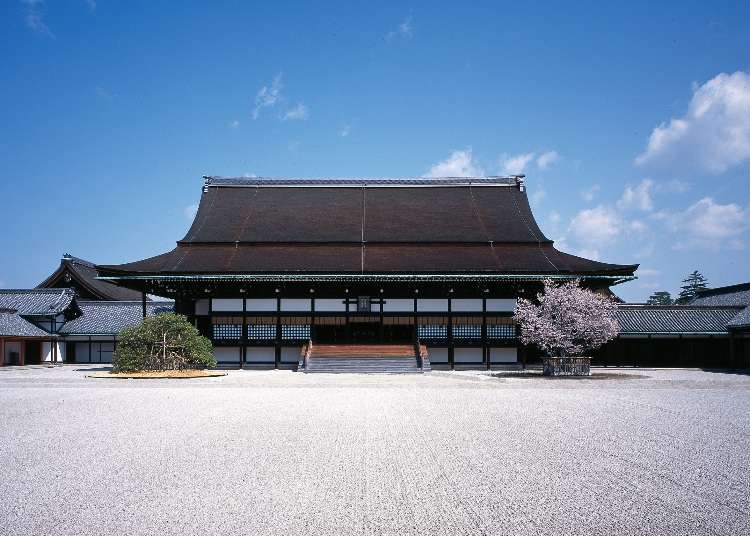
Kyoto Imperial Palace is a hotspot for tourists. Surrounded by the greenery of the national garden, this is where generations of emperors lived for around 540 years, from the time Emperor Kogon ascended to the throne in 1331 until Emperor Meiji transferred the palace to Tokyo in 1869.
With its role as imperial palace completed, today the palace is open to the public year-round, available for viewing without prior reservation.
As an important facility to the imperial household, you cannot enter inside the building, but a tour route has been set up to allow viewing of some of the palace's many valuable furnishings.
From the screen door paintings that adorn the rooms to the seasonal changes of the courtyard, the Kyoto Imperial Palace is full of interesting features. This article will guide you through a list of 5 spots that are especially worth checking out.
- Table of Contents
-
- Highlight 1: The Striking Screen Door Paintings in "Shodaibunoma"
- Highlight 2: The "Shishin-den" Ceremonial Hall and its Traditionally Crafted Roof
- Highlight 3: The "Seiryo-den", with Two Guardian Statues
- Highlight 4: The Seasonal Changes in the "O-ikeniwa"
- Highlight 5: "Otsune-goten", Home of Emperor Meiji
- What Are Some Things to Be Careful About When Visiting the Kyoto Imperial Palace?
Highlight 1: The Striking Screen Door Paintings in "Shodaibunoma"
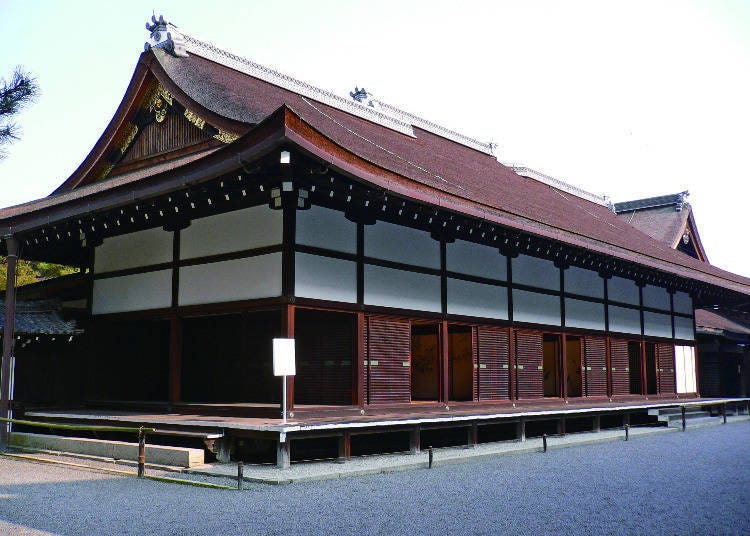
The entrance and exit to the Kyoto Imperial Palace tour route is the Seisho-mon Gate, located on the western side of the palace. Once you enter through the gate, on your right will be the Mikurumayose, used as the official main entrance for visitors.
Through there is the "Shodaibunoma" hall, which used to be the visitor waiting room. The building consists of three main rooms, each of which is named after the paintings on their fusuma screen doors: Tora-no-Ma" (Tiger Room), "Tsuru-no-Ma" (Crane Room), and "Sakura-no-Ma" (Cherry Blossom Room).
The screen door paintings can be viewed from the tourist path. Among the rooms, you'll want to pay special attention to the Tora-no-<a, with its dynamic and powerful paintings of tigers about to drink water and adorably frolicking.
Highlight 2: The "Shishin-den" Ceremonial Hall and its Traditionally Crafted Roof
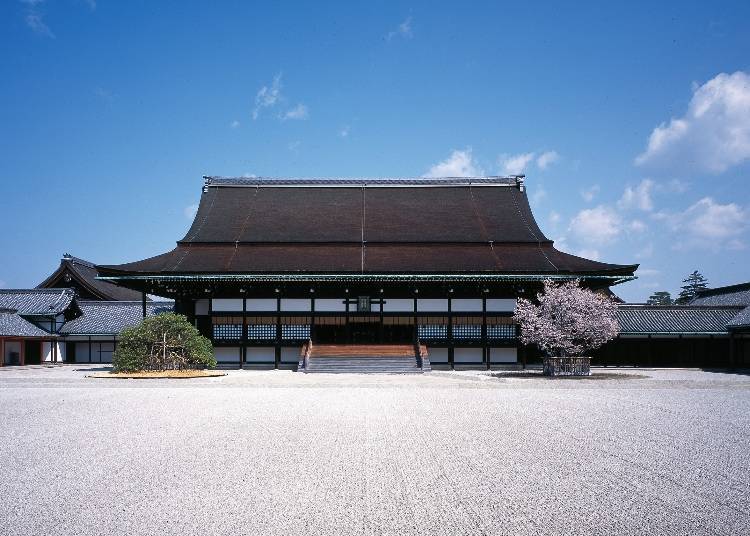
The main hall called the Shishin-den, surrounded by a corridor of white walls and vermillion-red colored pillars, is the most formal hall of the palace, where important ceremonies such as ceremonies of the Accession to the Throne were held. The roof was constructed using the traditional method "hiwadabuki", by which bamboo nails are used to thatch pieces of cypress bark into layers of roofing.
Inside the building, with its raised-floor style palace construction, are the thrones for the emperor and empress, called Takamikuna and Michodai. In front of the Shishin-den hall is the white sand southern garden, and when facing the hall, to your left will be the "rightward tachibana tree" and to your right the "leftward cherry tree".
Highlight 3: The "Seiryo-den", with Two Guardian Statues
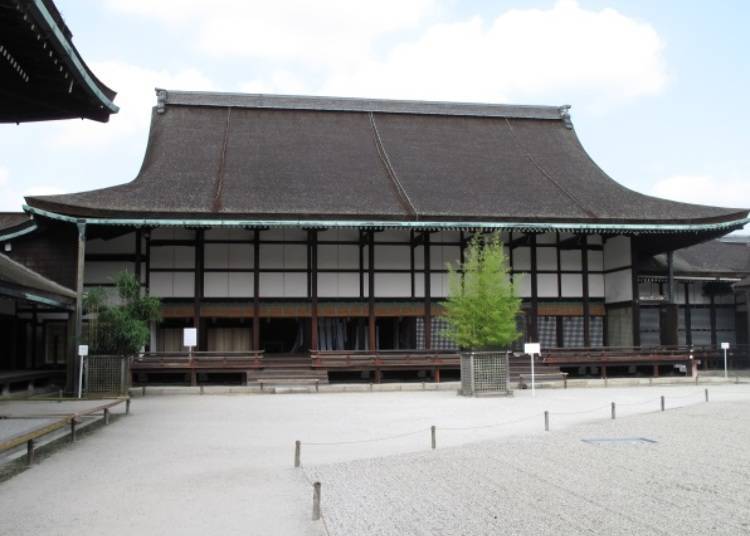
The Seiryo-den is a reconstruction in Heian period style, with a gabled, cypress-thatched roof and shinden-zukuri layout.
In contrast to the Shishin-den's usage for important, formal ceremonies, the Seiryo-den was used by the emperor for living quarters. Inside the center of the building is the "michodai", a curtained platform used by the emperor for sleeping and resting.
The thick tatami mat set in front of the michodai is called hi-no-omashi, and was used by the emperor to sit on throughout the day. In front of the michodai are statues of a guardian lion and a guardian dog, which are often seen at shrines as a custom dating from the Heian period.
In the eastern garden of the Seiryo-den are bamboo trees called "kawatake" and "kuretake". Like the cherry and tachibana trees in front of the Shishin-den, these two bamboo trees are an essential part of the garden, and are said to have been used as markers when aligning on the garden.
Highlight 4: The Seasonal Changes in the "O-ikeniwa"
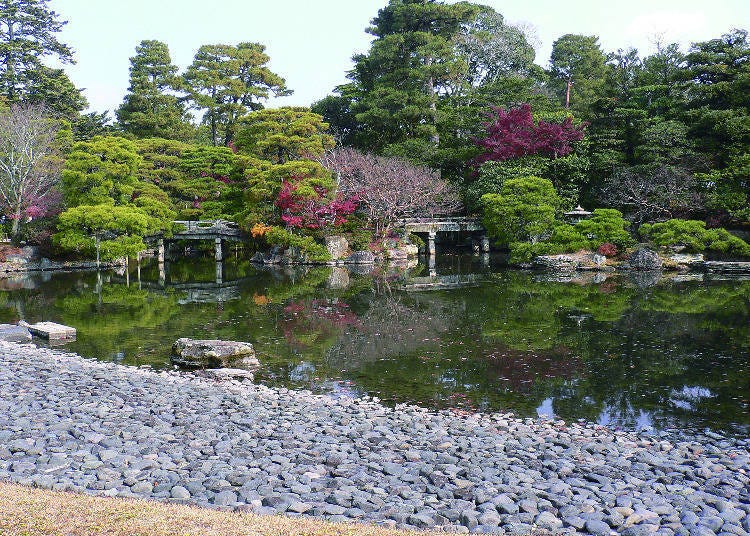
A courtyard known as "O-ikeniwa", or pond garden, can be found in the area before the imperial study and the kogosho.
The pond garden, built in the style of a garden circuit surrounding a pond, is said to have been constructed by Samurai general Maeda Gen-i and later improved upon by Kobori Enshu.
The area directly front of the pond is laid with natural pebbles, representing a beach. On the right is a bridge called "keyaki-bashi", and trees grow on the opposite shore. With wild birds and colorful fall leaves, the garden's scenery changes with each of the seasons, breathtakingly beautiful no matter what time year you visit. (Visitors are not allowed to enter the garden.)
Highlight 5: "Otsune-goten", Home of Emperor Meiji
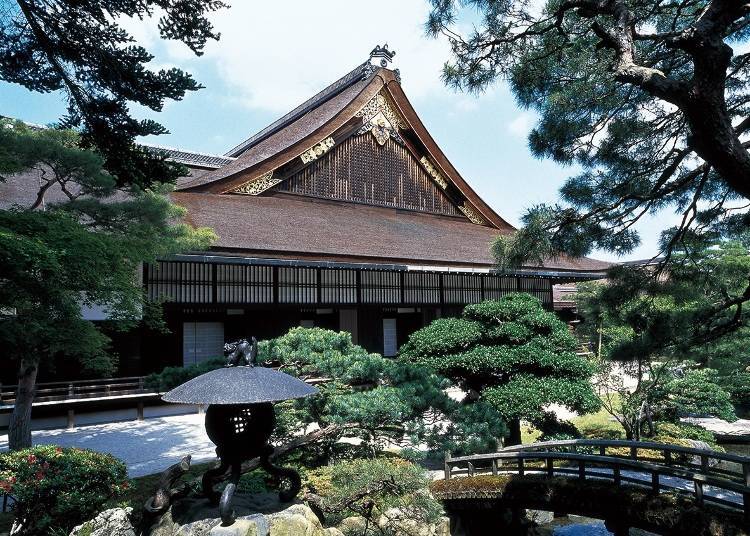
The Otsune-goten is the largest building of the Imperial Palace. After the Seiryo-den came to be used for ceremonies in the 16th century, the building was constructed as a new place for the emperor's living quarters.
The present-day version of the Otsune-goten was reconstructed in 1855, and Emperor Meiji is said to have lived there until he moved to Tokyo. To the east is the "go-naitei" garden, with a stream and earthen, stone, and wooden bridges. The majority of the bridges, lanterns, and stones that accentuate the garden were given as offerings to the emperor.
What Are Some Things to Be Careful About When Visiting the Kyoto Imperial Palace?
The Kyoto Imperial Palace is an imperial household-related facility. For security purposes, your personal belongings will be inspected at the Seisho-mon Gate. Dangerous items, large baggage such as suitcases, and pets are not permitted to be brought inside.
Smoking, eating, drinking, and art sketching are not allowed inside the palace. Photography is allowed, but drones and tripod photography are not permitted. Additionally, an alarm will sound if you get too close to the wall surrounding the palace, so take care where you walk.
The Imperial Palace is floored with gravel, so wearing comfortable walking shoes is recommended.
-
Kyoto Imperial Palace京都御所
- Address 3 Kyoto-Gyoen, Kamigyo-ku, Kyoto City, Kyoto 602-0881
-
Nearest Station
5-minute walk from Kyoto Municipal Subway Karasuma Line "Imadegawa" Station, or a 5-minute walk from "Karasuma Imadegawa" bus stop
Entrance Fee: free
Visiting Hours: Please check the website: http://sankan.kunaicho.go.jp/english/guide/kyoto.html
Closed: Mondays (the following day in the event Monday falls on a national holiday), and December 28 - January 4
Text by:Word
- Area
- Category
*Prices and options mentioned are subject to change.
*Unless stated otherwise, all prices include tax.
Popular Tours & Activitiess
Recommended places for you
-

ISHIDAYA Hanare
Yakiniku
Kobe, Sannomiya, Kitano
-

Kambei Sannomiyahonten
Yakiniku
Kobe, Sannomiya, Kitano
-
Goods

Yoshida Gennojo-Roho Kyoto Buddhist Altars
Gift Shops
Nijo Castle, Kyoto Imperial Palace
-

Jukuseiniku-to Namamottsuarera Nikubaru Italian Nikutaria Sannomiya
Izakaya
Kobe, Sannomiya, Kitano
-

Osaka Aquarium KAIYUKAN
Zoos, Aquariums & Botanical Gardens
USJ, Nanko Port
-

Kanzenkoshitsuyakinikutabehodai Gyugyu Paradise Sannomiya
Yakiniku
Kobe, Sannomiya, Kitano
-

Everything You Need to Know About teamLab Biovortex Kyoto (2025 Insider Guide)
by: Wemmy Chau
-

Best Things to Do and See Around Kyoto & Osaka in September: Events and Festivals in Kansai
-

November Events in Kansai: Fun Festivals, Food, and Things to Do in Kyoto & Osaka
-

Curious About Sake? I Visited a Sake Brewery in Japan and Here's What I Learned
-
Ad

Recharge and Relax with a Healing Getaway at Kamenoi Hotel Toba
-
Ad

Visiting the Osaka–Kansai Expo? Enjoy These 5 Great Itineraries from Osaka-umeda for Nature and City Lovers
Inspiration for Accommodations
-

Spacious Family Hotel in Namba: 20 Comfortable Stays for Family Fun
-

Charming Hotels to Enjoy the Spectacular Views of Arashiyama's Autumn Leaves from Your Room
-

Experience Stunning Views of Osaka Castle from Private Spaces: Top Hotels Near Osaka Castle
-

Recommended by Visitors! Arashiyama's Best-Rated Hotels
-

Family-Friendly Universal Studios Japan Hotel with Excellent Access
-

Enjoy a Comfortable Stay in Osaka! 10 Hotels with Convenient Airport Shuttle Services
-

Top 10 Recommended Hotels Near Namba Station with Great Access
-

Enjoy Night Views from Your Room! Recommended Hotels in Namba Area
-

5 Popular Things to do in Umeda - Osaka's Central Area!
by: WESTPLAN
-

Abeno Harukas: MUJI Café and Crazy Osaka Views?! Best Things to do at Japan’s Tallest Building
by: WESTPLAN
-

3 Best Hotels in Kobe, Japan with Amazing Views of Kobe Bay!
-

Visiting Tsutenkaku Tower: Osaka's Retro Icon in the Heart of Shinsekai
by: Guest Contributor
-

Ippudo Osaka and More: These 5 Ramen Restaurants in Osaka Are Going Viral
by: WESTPLAN
-

Tsutenkaku's Fun 'Tower Slider' Is The Thrilling Addition To Your Osaka Trip
- #best gourmet Osaka
- #things to do Osaka
- #what to do in kyoto
- #what to bring to japan
- #best gourmet Kyoto
- #new years in Osaka
- #what to buy in nanba
- #Visiting Osaka
- #onsen tattoo friendly arima
- #daiso
- #Visiting Kyoto
- #best japanese soft drinks
- #japanese fashion culture
- #japanese convenience store snacks
- #japanese nail trends












